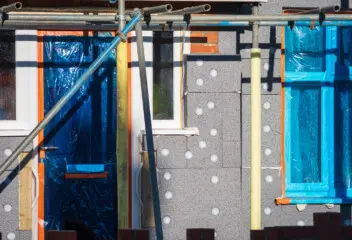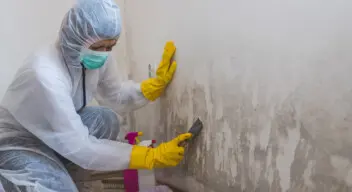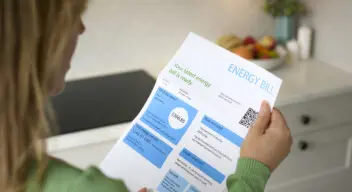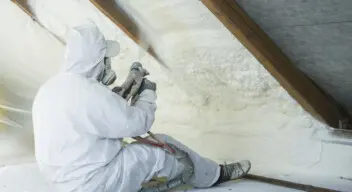Some 98% of homes with external wall insulation installed under the Government’s ECO scheme require work to correct major issues that will cause problems such as damp and mould, a damning National Audit Office report has revealed.
- External wall insulation problems: An estimated 22,000-23,000 homes with external wall insulation fitted under the scheme (98% of the total) have major issues that need fixing.
- Most of these cases (92%) have major issues that will affect the insulation’s performance, often creating the risk of water ingress and mould, while 6% have health and safety risks that require immediate correction, such as inadequate ventilation.
- Around 4,700 affected homes with external wall insulation problems have already been identified and around 1,900 homes have had the problems fixed.
Internal wall insulation problems
An estimated 9,000-13,000 homes with internal wall insulation (29% of those who’ve had this type of insulation fitted under the scheme) are affected. Most cases (27%) have major issues that will affect the insulation’s performance, often creating the risk of condensation and mould. While 2% have health and safety risks that require immediate correction, such as inadequate ventilation and poor electrical safety.
· More than 1,500 of homes with internal wall insulation problems have been identified and problems have been fixed in around 1,000 homes.
Why has the standard of installation been so poor?
The report says possible explanations of why so many installations have been carried out to such a poor standard include:
· An under-skilled workforce, with work being subcontracted to individuals and firms who are not competent or certified,
· Uncertainty over which standards apply to which jobs, and
· Businesses ‘cutting corners’ when undertaking design and installation work.
The Department for Energy Security and Net Zero (DESNZ) implemented a new consumer protection system for the scheme in 2021, which included appointing TrustMark as its government-endorsed quality scheme.
But the NAO report says this system failed to flag significant problems with the quality of installations until October 2024 – by which point, people with cases of bad mould in their homes had already spoken out in the press.
The NAO report said reasons for the ECO scheme’s shortcomings include:
- Weak government oversight resulting in widespread issues with the ECO scheme not being identified sooner,
- An overly complex consumer protection system that ultimately failed,
- TrustMark’s funding arrangements limiting its ability to have analytical systems fully up and running until the latter half of 2024,
- Insufficient audit and monitoring, in part due to weaknesses that allowed installers to ‘game’ the system.
This report is the latest blow for homeowners who had believed they were benefiting their homes and the environment by insulating their homes via the ECO scheme.
External wall insulation problems – what we knew already
In January 2025, homeowners were warned that if they’d had solid wall insulation fitted under the Energy Company Obligation 4 and Great British Insultation Schemes (GBIS) since 2022, it may be ‘substandard’.
Routine checks carried out by Trustmark had uncovered examples of solid wall insulation problems including:
- Insufficient ventilation, or missing or exposed insulation, which if left unchecked could lead to damp and mould.
- In the ‘very small number’ of properties with health and safety concerns, including wires not being fitted properly, the problems are ‘being fixed urgently, with the expectation that they should be resolved within 24 hours’.
- Missing or incomplete paperwork.
As a result of the findings, 39 businesses were suspended from installing solid wall insulation in government schemes and installers responsible for the substandard work would be required to fix the work at no cost to households, Minister for Energy Consumers Miatta Fahnbulleh told the House of Commons on Thursday 23 January. Find a list of the suspended businesses here.
Installers responsible for substandard work will remain banned from installing new solid wall insulation on any government scheme if they don’t fulfil their obligation to put any issues right.
In addition to these issues, in November 2024 Ofgem estimated that businesses had falsified claims for ECO installations in between 5,600 and 16,500 homes, potentially claiming between £56 million and £165 million from the energy suppliers operating under the scheme.
How many people are affected?
Just over 65,000 households have had external wall insulation and internal wall insulation measures fitted using the Energy Company Obligation 4 (ECO4) scheme and Great British Insulation Scheme, according to official government figures.
Of these, an estimated 22,000 to 23,000 homes with external wall insulation fitted under the scheme and 9,000 to 13,000 homes with internal insulation have major solid wall insulation problems that need fixing.
What to do if you think you may be affected:
1. The original installer is liable for the whole cost of repairing faulty installations in affected homes, says the National Audit Office.
2. To arrange an audit of their home so that repairs can be arranged, affected households should contact Ofgem. The Ofgem ECO helpline can be contacted at 0808 169 4447 or ECOhelp@ofgem.gov.uk.
Expert view: Homeowners failed yet again
Paula Higgins, CEO of the HoneOwners Alliance says, “This is an absolute disgrace. Once again, public money has been used to fund cowboy builders, leaving homeowners with damp, mouldy and unsafe homes. The National Audit Office report lays bare how weak oversight and a broken consumer protection system have failed the very people these schemes were meant to help.
It’s yet more evidence that the government must act urgently to regulate and license builders and installers — something we have long campaigned for. Without proper regulation, homeowners will never have the confidence to invest their hard-earned money in improving their homes.
Frankly, the TrustMark model is not working. As a government-endorsed quality scheme, it is meant to safeguard standards across ECO projects, yet the system of sub-licensing ‘scheme providers’ and fragmented oversight has clearly failed. Trust is hard to earn — and even harder to win back once lost.
We fear this is only the tip of the iceberg. External and internal wall insulation account for just 8% of installations under these schemes, leaving 92% still unexamined. We urge the Government to take action on these other measures — and in particular to look at spray foam insulation, which extends beyond government-endorsed schemes. We continue to hear alarming stories of homeowners left with unmortgageable properties due to shoddy installation and weak oversight. Despite writing to Ministers twice, we have received no meaningful response. Unless swift action is taken, this risks becoming the next major scandal.
In the meantime, we are deeply concerned for the stress and upheaval this will cause affected homeowners. Our website provides guidance on what the NAO report means, practical next steps for homeowners, and a place for them to share their experiences.”
KEY INFORMATION
What is solid wall insulation?
There are two types of solid wall insulation: internal wall insulation and external wall insulation. It’s used by people who have solid walls– and therefore you can’t install cavity wall insulation – to make their home more energy efficient.
With both types, if you have solid walls you’ll need to ensure they can breathe, otherwise you’re at risk of damp issues.
1. Internal wall insulation
Internal wall insulation involves fitting insulation boards to the walls inside your home. Or by fitting a stud wall filled with insulation material.
The cost of internal wall insulation depends on how many rooms you are renovating, the size of the walls and the type of material being used. But Energy Saving Trust estimates installing internal wall insulation in a typical three-bedroom semi-detached home would be £7,500.
2. External wall insulation
External wall insulation involves fixing a layer of insulation material on your home’s exterior walls, then covering it with a special type of plasterwork or cladding.
According to Checkatrade, the cost of external wall insulation is usually around £100 per sq/m. And the average cost ranges from £8,000 for a small flat, rising to £22,000 for a large detached house.
Find more information on these and other types of insulation in our guide How to make your home more energy efficient.
What can go wrong with solid wall insulation?
Damp and mould
- Houses built with solid walls were designed to breathe to allow water vapour to escape through the walls. Wrapping a home in external wall insulation will cut down on draughts and increase insulation. But a major solid wall insulation problem is that if it’s installed poorly, it reduces ventilation and could create a barrier that keeps moisture within the house. If this happens, the long-term problem is damp and mould. There are similar risks with internal wall insulation.
Water ingress
- If the gaps external wall insulation are not sealed properly, water could seep in and damage the structure of the building.
Thermal bridging
- If external wall insulation is incorrectly installed, you could end up with weak points that allow for heat to pass through more easily, defeating the object of installing it.
Reduced floor space
- If you fit internal wall insulation, you’ll have less floor space in your rooms as the thickness of the insulation is around 10cm, according to Energy Saving Trust.
What is the Energy Company Obligation Scheme?
If you meet certain criteria, you may be eligible to have multiple energy-efficiency improvements to your home under the Energy Company Obligation (ECO). It requires energy suppliers to help households cut their heating costs by fitting energy-saving measures ranging from loft and wall insulation to air source heat pumps.
The current scheme ECO4, which runs until 31 March 2026, focusses on improving the least energy efficient homes (properties with an EPC rating rating of D-G) and households in fuel poverty. The scheme also aims to deliver a more complete upgrade of those homes, shifting to a multi-measure ‘whole-house retrofit approach’.
Under the ECO4 scheme you may also be able to get your boiler repaired, upgraded or even replaced, and if you own your own home, you might qualify for free heating controls, such as thermostatic radiator valves, as well as other measures such as improved window glazing. These measures are not available under the Great British Insulation Scheme.
What is the Great British insulation scheme?
This extends the support offered by the ECO4 scheme to those who don’t receive government benefits. The scheme is open to homeowners, landlords or tenants. But if you’re renting, you’ll need your landlord’s permission before any insulation can be installed.
You may get support if your home:
The types of insulation you may be able to get support to install include cavity wall insulation, solid wall insulation (internal or external), loft insulation, flat or pitched roof insulation, underfloor insulation, solid floor insulation and room-in-roof insulation
You can check your eligibility. However, you’ll only be able to get one type of insulation installed and you may need to pay a proportion of the costs.
Find out in a matter of minutes whether you qualify for the Great British Insulation Scheme by using this online eligibility checker. If you’re eligible, your energy supplier will contact you within 10 working days asking for extra information and to arrange an assessment of your property. Alternatively phone 0800 098 7950 or contact your supplier directly.
Find more on these and other help available in our guide on Energy grants and how to get them.





 November 24, 2025
November 24, 2025 


